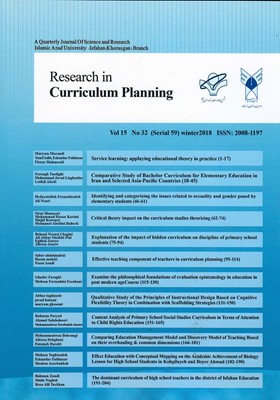تأثیر آموزش به کمک نقشة مفهومی بر پیشرفت تحصیلی درس زیستشناسی دانشآموزان سال سوم متوسطه استان کهگیلویه و بویراحمد
الموضوعات : پژوهش در برنامه ریزی درسیمحسن تقی زاده 1 , اسکندر فتحی آذر 2 , مسلم آذر بخش 3
1 - دانشجوی دکتری رشتة مطالعات برنامه درسی، گروه علوم تربیتی، دانشکده علوم ترتبیتی و روانشناسی، دانشگاه اصفهان، اصفهان، ایران.
2 - عضو هیئتعلمی و استاد گروه علوم تربیتی، دانشکده علوم تربیتی و روانشناسی- دانشگاه تبریز، تبریز، ایران.
3 - دانشآموخته رشتة مطالعات برنامه درسی، دانشکده علوم تربیتی و روانشناسی-دانشگاه تبریز. تبریز، ایران.
الکلمات المفتاحية: یادگیری معنیدار, نقشة مفهومی, یادگیری زیستشناسی,
ملخص المقالة :
این پژوهش با هدف تعیین تأثیر شیوة آموزش به کمک نقشة مفهومی بر میزان یادگیری درس زیستشناسی و بهویژه در راستای یادگیری معنیدار اجرا شد. برای این منظور از یک طرح نیمهآزمایشی با پیشآزمون و پسآزمون استفاده شد. جامعة آماری این پژوهش دانش آموزان سال سوم متوسطه علوم تجربی استان کهگیلویه و بویراحمد در سال 92-93 بود که دو کلاس به روش نمونهگیری هدفمند (که هر کلاس شامل 20 نفر بود) انتخاب شدند که در گروه کنترل فراگیران به شیوة مرسوم درسهای مذکور را یاد میگرفتند و در گروه آزمایشی، مطالب درسی در قالب نقشههای مفهومی به دانشآموزان ارائه شد. تأثیر این کاربندی بر پیشرفت تحصیلی فراگیران در درس زیستشناسی از طریق آزمونهای پیشرفت تحصیلی با شاخصهای مقبول روایی و پایایی اندازهگیری شد. یافتههای پژوهش حاضر نشان میدهد که آموزش نقشة مفهومی بر میزان پیشرفت تحصیلی درس زیستشناسی و همچنین یادگیری معنادار آن تأثیر مثبتی داشته است.
Akinsanya,c. Williams, M. (2004). Concept mapping for meaningful learning.Nurseeducation teday, 24, 41-46.
Alipour, M. pourmohamadrezatajrishi,M. Davarmanesh, A. (2011). The comparison and the effectiveness of conceptual map teaching and lecturing methods on the achievement of socio-economic skills course in 3rd grade students with intellectual disability. Journal of Modern psychological Researches, 6(24), 97-116. [In Persian]
Ashoori,J. Kajbaf,M, B. Maneshei, GH. Talebi, H. (2013). The effect of conceptual mapping, collaborative and traditional teaching methods on the incentive to Progress and academic achievement in Biology course. Research in curriculum planning. 11,14, 63-73. [In Persian]
Buldu, Mehmet. Buldu,Nihal. (2010). Concept mapping as a formative assessment in collegclassrooms:measuring usefulness and student satisfaction.Procedia social and Behavioral sciences, 2, 2099-2104.
Canas, A. Novak, J. D. Reiska, P. Ahlber, M, K. (2008). Concept Mapping: Connection Educators. The Proceedings of 3 rd International Conference on Concept Mapping. Estonia & Finland, September 22-25.
Chen,Nian-Shing. Kinshuk.Wei, Chun-Wang. Chen, Hong-Jhe. (2008).Mining e-learning domain concept map from academic articles. Computer & Education,50, 1009-1021.
Chiou,c.c. (2008). The effect of concept mapping on students learning achievements and interests. Innovations in Education and Teaching International,45(4),375-387.
Chu,Kuo-kuang. Lee, chien-I.Tsai,Rong-shi. (2011).ontology technology to assist learners navigation in the concept map learning system.Expert system with Applications,38, 11293-11299.
Cline,Ben. E. Brewster, Clarlyle C. Fell,Richard. D. (2010).A rull-based system for automatically evaluating student concept maps.Expert System with Applications, 37, 2282-2291.
Fathi azar,A. (2008). Methods and techniques of teaching.Tabriz, Publication University of Tabriz,p 120.]In Persian[
Garabet, Mihaela.Miroon, cristina. (2010).conceptual map didactic method of constructiveist type during the physics lessons.Procedia social and behavioral sciences, 2, 3622-3631.
Ghanbari, A.paryad, A.ahsany, M. (2010). The effect of concept mapping on learning and retention of teaching a course on nursing students. Journal of Medical Education Development Center, 2, 118-112.]In Persian[
Guliz, A. & Gunay, B. (2009). Technologically – supported mind and concept maps prepared by students on the subjects of the unit “system in our body”. Journal of Procedia Social and Behavioral Sciences, 1, 2838- 2842.
Hendijanfard, fateme.Kardan,Ahmad.Dibaymoghadam, Mohammad. (2011).ICAMP:An interactive tool for concept map generation to facilitate learning process.Procedia computer science, 3, 524-529.]In Persian[
Hooman, H. (2007). Understanding the Scientific Method in the Behavioral Sciences. Tehran, Publication Samt,p 350.]In Persian[
Lee, Y. & Nelson, D.W. (2005). Viewing or Visualizing – Which Concept Map Strategy Works Best on Problem – solving Performance? British Journal of Education Technology, 36,193-203
Melek, C. (2010). An examination of concept maps created by prospective teachers on teachers roles. Journal of Procedia Social and Behavioral Sciences, 2, 2464-2468.
Mih, Codruta.Mih,Viorel. (2011).Conceptual maps as mediators of self-regulated learning.Procedia social and behavioral sciences, 29, 390-395.
Msrabady, J. Alilu, A. (2016). The effectiveness of concept mapping on retention and understanding and application of concepts of science. Journal of Educational Psycholog,151-171.
Msrabady, J.Hosseieni nasab,D. Fathi azar,A. Moghaddam, M. (2008). Effectiveness of
teaching and learning strategies for concept map based on cognitive-emotional outcomes in learning biology course. Journal of Psychology, University of Tabriz, 8, 132-109.]In Persian[
Piri, M. Azizi, H. Mesrabadi, J. (2017). The Effectiveness of Concept Map Based Instruction on Concept Retention and Comperhension in Science and Social Lessons in the Elementry Sixth Grade. Research in Curriculum Planning. 14,28, 91-99.
Sarhangi, f. Masumi, M. Seyyed Mazhari,A.Rahmani,M.Risyfar,A. (2010). Effectiveness of teaching critical thinking skills of nursing students' conceptual map. Journal of Critical Care Nursing, 4, 148-143.]In Persian[
Shabani, H. (2008). Educational skills. Tehran: Publication Samt,p230.]In Persian[
Taskin,Mine.Pepe,Hamdi.Taskin,Cengiz.Gevate,Cecilia.Taskin,Halil. (2011).The effect of concept maps in teching sportive technique.Procedia social and behavioral sciences,11,141.
Tseng, Shian-Shyong.Sue,Pei-Chi.Su,Jun-Ming.Weng, Jui-Feng.Tsai,Wen-Nung. (2007).A new approach for constructing the concept map.Computer& Education,49, 69.
_||_

